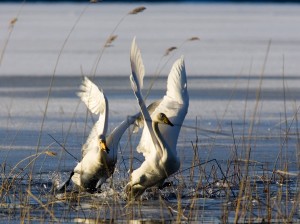Wetlands Trust celebrates 65 years
 One of the world’s largest wetland conservation organisations celebrates its 65th anniversary today.
One of the world’s largest wetland conservation organisations celebrates its 65th anniversary today.
The Wildfowl & Wetlands Trust has saved species, pioneered scientific research and helped governments and communities reap widespread benefits from wetlands.
Since its formation at Slimbridge in 1946, as the Severn Wildfowl Trust, WWT has opened eight more centres, covering 2,600 hectares, in England, Scotland, Wales and Northern Ireland.
Six of those sites are part of larger Ramsar wetlands – areas recognised globally for their high wildlife value. More than one million people visit WWT reserves every year, over half of whom are children.
Martin Spray, Chief Executive of WWT, said: “WWT has become a major force in wetland conservation in a very short time.
“Our science has saved species and our centres have become hubs of learning, inspiration and recreation. WWT’s founder Sir Peter Scott saw that enthusing people about nature was paramount, a principle that remains at the heart of all we do.
“Wildlife would be devalued without it, and our attempts to conserve nature for future generations would fail.”
Sir Peter’s work to save endangered species set high standards for conservation today. He dreamt of combining wildfowl research and education in one body choosing Slimbridge as the new Trust’s headquarters because of the area’s importance to wildfowl.
In his autobiography, The Eye of the Wind, he wrote of “the scientific and educational effort which I believed was so badly needed for the conservation of wildfowl.”
Martin Spray said: “While others were putting ‘keep out’ signs on nature reserves in the misguided view that it would protect them, Peter opened the doors to Slimbridge and welcomed people in.”
WWT’s achievements span continents. In 1962, Hawaiian geese reared at Slimbridge were reintroduced to Hawaii effectively saving the species. WWT as subsequently worked on wetland species and habitat projects in Europe, Asia, South America and Africa.
WWT’s London Wetland Centre, one of the largest man-made wetlands in any major city, was opened in 2000.
The Trust was part of a coalition campaigning against a damaging and costly tidal barrage across the Severn Estuary.
Last month, WWT signed an important agreement with the Ramsar Convention, forging closer ties with the treaty’s 160 partner governments.
Trust staff have also become global experts in rearing rare birds to create a captive population for eventual reintroduction to the wild. Their work is currently helping spoon-billed sandpipers and the Madagascar pochard, both of which face extinction.
Ends
For more information contact the WWT press office on 01453 891162 or email prteam@wwt.org.uk.
Top 10 WWT achievements
1962 the first Slimbridge-reared nene (Hawaiian goose) are released into the wild in Hawaii. Reintroduction prompts the recovery of the world nene population which had fallen to 30 by 1951.
1969 plans to build a dam at the main area for breeding Pink-footed Geese in Thjorsarver, Iceland are dropped after successful lobbying by WWT.
1973 Sir Peter Scott knighted for his services to conservation.
1975 WWT recreates wetland at Martin Mere, Lancashire. Ten years later the site wins Ramsar designation.
1993 The main white-headed duck wintering site at Burdur Golu, Turkey is formally protected, following a collaborative study initiated by WWT.
1999 the long-term protection of barnacle geese at Caerlaverock, Scotland by WWT and others helps the Svalbard barnacle goose population to reach 25,000 after dropping to just 300 in 1948.
2000 The WWT London Wetland Centre opens and is one of the largest created wetlands in any major city.
2002 WWT designs the International Wetland Park in Hong Kong – opens 2006
2003 Carmarthen Bay is made the UK’s first marine Special Protection Area under European law after WWT surveys show its importance for common scoters.
2011 WWT signs a Memorandum of Cooperation with the Ramsar Convention, forging closer links with the treaty’s 160 signatory governments.
Notes to editors
- Wetlands can be ponds and lakes, riverbanks, peatlands, marshes or fens, fresh and saltwater sites, and coasts. They are defined by Ramsar as ‘areas where water is the primary factor controlling the environment and the associated plant and animal life’.
- Wetlands provide food, clean water and livelihoods to around 400 million people worldwide. They account for 6% of the Earth’s surface but store 35% of terrestrial carbon. They also store water so reducing the impact of extreme weather and tides. Wetlands absorb pollutants.
- At least 50% of wetlands globally have been lost in the last century. Threats include population growth, development, agriculture and pollution.
- Wetlands harbour 40% of world’s known species. More than 146 threatened bird species depend on wetlands.
- WWT is working with conservationists in Guyana to alleviate the environmental effects of mining and logging, and training people living in China’s Yangtze floodplain to monitor wildlife, disease and water quality. In Laos, WWT is helping install wetland treatment systems close to the capital Vientiane to replicate the water quality and wildlife benefits of the 2,000 hectare Luang Marsh, parts of which are being reclaimed or polluted. In Nepal, WWT and Bird Conservation Nepal are facilitating alternative livelihoods for people reliant on the Koshi Tappu Wildlife Reserve to overcome antipathy to its protection and overuse of its resources.
- WWT’s centres are important wintering sites or migration stop-overs for several species of geese, Bewick’s and whooper swans, lapwing, redshank and black-tailed godwit. Some WWT reserves harbour water voles and beavers.
- WWT has more than 200,000 members. Over 20 million people have visited WWT centres since 1946.

